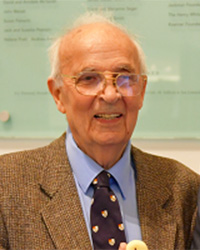Queen’s remembers Professor Emeritus George Ewan
December 17, 2020
Share

Queen’s University is remembering George Ewan, Professor Emeritus in the Department of Physics, Engineering Physics, and Astronomy and a founding member and joint leader of the SNO (Sudbury Neutrino Observatory) collaboration. Dr Ewan died on Monday, Dec. 7, at the age of 93.
Dr. Ewan played a key role in advancing the understanding of solar neutrinos, fostering support for and leading the fundraising effort to build a low-radioactivity laboratory located 2 km underground in Sudbury mine.
Noted for his calm, friendly, and skilled scientific leadership, he was a major contributing factor in the success of the SNO experiment.
“George was well-known internationally as a great scientist, a wonderful human being and a pioneer and leader in the field of particle astrophysics in Canada,” says Professor Emeritus Arthur McDonald, the 2015 Nobel Laureate in Physics for his research into neutrinos conducted at SNO. “He was a mentor for me throughout my career and I will miss him.”
Dr. Ewan studied at the University of Edinburgh, earning a BSc (1st class honours) in physics in 1948, then receiving his PhD in nuclear physics in 1952. He then worked in Canada as a Post-Doctoral Fellow at McGill University until 1955 when he accepted a research position at Chalk River Nuclear Laboratories. He would be promoted to Senior Research Officer, a position he would hold from 1962-70.
In 1970 he moved to Queen’s University, joining the Department of Physics, Engineering Physics and Astronomy. He would serve as the Department Head from 1974-77 and was appointed Professor Emeritus in 1994. He was the author of more than 110 front-line publications in nuclear and particle physics.
Dr. Ewan was a well-known expert in nuclear physics and was recognized by the American Nuclear Society for the first use of a germanium gamma ray detector in a nuclear physics experiment. This type of detector revolutionized the science of gamma ray detection, providing vastly improved resolution and leading to many applications in nuclear science, medicine and industry.
But it is his accomplishments in enabling the success of the SNO project for which he is best known.
Dr. Ewan was the original Canadian spokesperson for the SNO project when it was founded in 1984, together with Herb Chen of University of California, Irvine. They were joined the next year by David Sinclair as UK spokesperson. He worked tirelessly in the physical, scientific, and political development of the project, leading to its funding in 1989. He continued to play a substantial role as chair of the SNO Scientific Management Committee before and after his retirement from Queen’s.
In 2017 Dr. Ewan and his wife Maureen donated $100,000 to Queen’s to create George and Maureen Ewan Lecture Series, now held annually bringing leading scientists to Queen’s to discuss their work in terms that “doesn’t require a PhD to understand.”
“George was a visionary scientist, fabulous colleague and mentor, and one of the founding fathers of the SNO experiment which led to a Nobel prize and the positioning of Canada as a world leader in astroparticle physics,” says Tony Noble, Canada Research Chair in Particle Astrophysics and the inaugural scientific director of the Arthur B. McDonald Canadian Astroparticle Physics Research Institute. “George’s passion for science, mentorship, and student engagement will live on through his generous philanthropic contributions and the George and Maureen Ewan lecture series.”
Dr. Ewan received many honours throughout his career, including the Canadian Association of Physicists (CAP) Gold Medal for Lifetime Achievement, the Radiation Industry Award of the American Nuclear Society, the Sigma Xi Fund of Canada Award for Scientific Achievement, The Breakthrough Prize in Fundamental Physics and the NSERC John C. Polanyi Prize with the SNO Collaboration and Honorary Degrees from Laurentian University, the University of Guelph and Queen’s University. He was a Fellow of the Royal Society of Canada, the Royal Society of Edinburgh, the Royal Society of Arts and the American Physical Society.